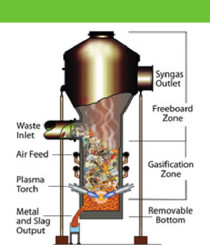The Application
Plasma arc & Gasification
An electric arc is an electrical breakdown of a gas that generates an ongoing plasma discharge. This occurs when a current flows through typically nonconductive media like air. Plasma gasification, a waste treatment technology, utilizes high electrical energy and high temperatures produced by an electrical arc gasifier. This arc breaks down waste primarily into elemental gas and solid waste (inert ash) within a device known as a plasma converter. The process is designed to be a net electricity generator, depending on the composition of input wastes, and aims to reduce the volume of waste sent to landfills.
Relatively high voltage and high amperage electricity pass between two spaced electrodes, creating an electrical arc. Inert gas (either air or inert gases under pressure) is directed through the arc into a sealed containment containing waste material, where temperatures as high as 3,000°C (5,500°F) are achieved within the arc. At these extreme temperatures, most types of waste break down into basic elemental components in a gaseous form, while complex molecules are atomized, separating them into individual atoms.
The reactor operates at a slightly negative pressure, which means that the feed system is complemented by a gaseous removal system and later a solid removal system. Depending on the input waste (plastics, for example, tend to be high in hydrogen and carbon), gas from the plasma containment can be extracted as syngas and may undergo further refinement into various fuels at a later stage.
The plasma FILL reactor achieves a remarkable reduction in material input, up to 95%, and all the by-products generated in the reaction have commercial value. This means that nearly all waste introduced into the reactor can be completely eliminated. This fact revolutionizes traditional waste management practices, rendering landfills no longer "landlocked."
One of the most significant outcomes is the transformation of landfills into waste depots. In a facility where waste is converted into marketable products, the ability to continue attracting waste suppliers becomes a valuable asset.
There are two major costs that a plasma FILL plant can recoup:
1. Opportunity cost due to market mispricing and the lost value when a landfill is capped. Just like other physical assets, the value of land generally increases as its supply decreases. It's reasonable to assume that the cost of land, like oil, would rise as its availability diminishes. However, in practice, landfill managers do not typically increase costs as the facility's lifespan nears its end. The revenue lost due to permitting and municipal economic factors is suddenly regained with the introduction of the plasma FILL technology. This enables landfill owners to recover these previously lost costs by accelerating the rate at which they can accept waste.
2. The value of your assets diminishes with each arriving truck. The book value of your assets is reduced by the tipping fee for each arrival. If only 5% of your landfill is utilized for each truck, the value of each arrival is multiplied by a factor of 20. With the use of the infinite FILL service, where all commercial by-products are removed from your facility, the value of each incoming truck becomes mathematically infinite. This marks a complete transformation in the valuation of your business.
These are innovative approaches applied to an established technology, and as such, the specific valuation parameters for this reevaluation are not yet well-established. However, it is highly likely that the transition from landfill to waste depot offers multiple benefits for asset owners, including cost reduction, increased revenue flow, enhanced ability to finance ongoing operations, and the preservation of sustainable book asset value.
The introduction of plasma FILL reactors is unlikely to be rivaled by any other single capital improvement in terms of its dramatic impact on your assets.
Power generation
The power generation section of our facility is based on a conventional combined-cycle power plant, which is typically fueled with natural gas, making them some of the cleanest and most efficient power plants in existence. Our facilities, on the other hand, would primarily use clean synthesis gas or "syngas" as the main fuel source. This syngas is utilized in a gas turbine, where the expanding gases drive the turbine and power an electric generator. The hot exhaust from the gas turbine is directed to a steam generator, which produces steam to drive a steam turbine and another electric generator. Additionally, we employ Selective Catalytic Reduction (SCR) to remove any nitrogen oxides (NOx or smog).
Our facilities have the capacity to generate sufficient electricity at a single site to power nearly 40,000 homes. It is estimated that out of the electricity and energy generated through this process, 20% will be used for self-sustenance, and the remaining 80% can be sold to a local grid as green energy.
Furthermore, some of the heat generated by the gases can be harnessed to convert water into steam, which, in turn, can be used to generate electricity through steam turbines. This approach not only reduces greenhouse gas emissions but also helps prevent acid rain. Simultaneously, it results in the production of thousands of barrels of natural gas and Megawatt-hours of electricity. Electric power can be generated using either a conventional combined cycle (steam turbine, gas turbine) power plant or Solid Oxide Fuel Cells (SOFC) fueled by carbon monoxide and/or hydrogen.
By implementing technologies that utilize renewable resources like waste to produce energy without depleting the Earth's limited resources, we can usher in a new era of environmental responsibility and true energy independence.
Gasification
This is a process that transforms carbonaceous materials, such as coal, petroleum, biofuel, or biomass, into carbon monoxide and hydrogen by subjecting the raw material to high temperatures in the presence of a controlled amount of oxygen and/or steam. The resulting gas mixture is referred to as synthesis gas or syngas and serves as a valuable fuel source. Gasification is a versatile method for extracting energy from various organic materials.
The advantage of gasification lies in its potential for greater efficiency compared to the direct combustion of the original fuel. This is because syngas can be combusted at higher temperatures or even used in fuel cells, surpassing the thermodynamic upper limit defined by Carnot's rule. Syngas can be employed in various ways, including direct combustion in internal combustion engines, methanol and hydrogen production, or conversion through the Fischer-Tropsch process into synthetic fuel. Gasification can also process materials that are not typically considered viable fuels, such as biomass or organic waste. Additionally, high-temperature combustion during gasification removes corrosive ash elements like chloride and potassium, enabling clean gas production from otherwise problematic fuels.
Currently, gasification of fossil fuels is widely employed on an industrial scale to generate electricity. However, virtually any type of organic material can serve as the raw material for gasification, including wood, biomass, or even plastic waste. It's worth noting that gasification relies on chemical processes at elevated temperatures exceeding 700°C, setting it apart from biological processes like anaerobic digestion, which produce biogas.




